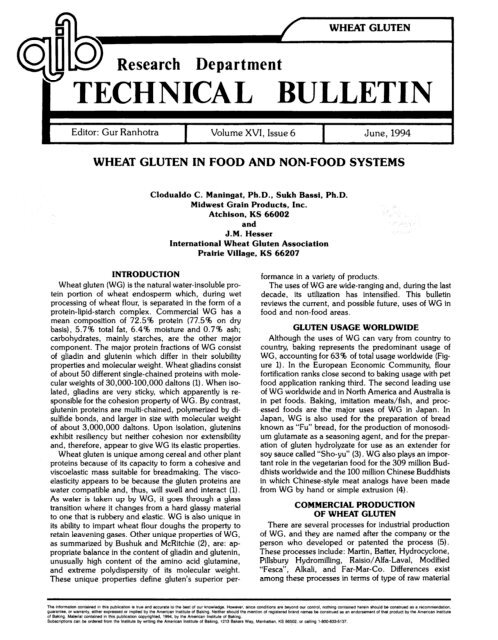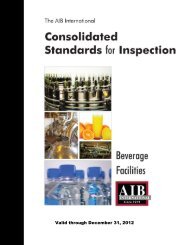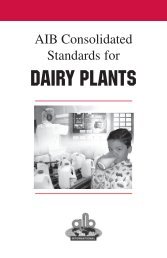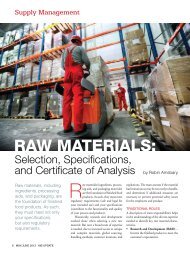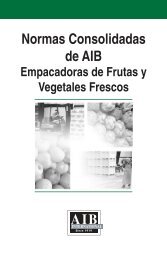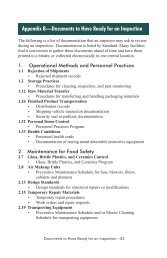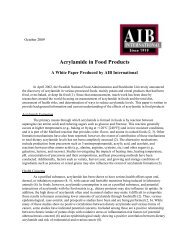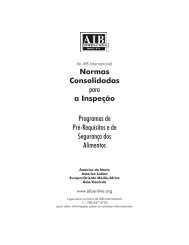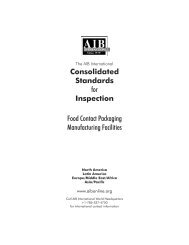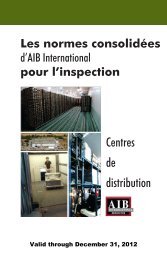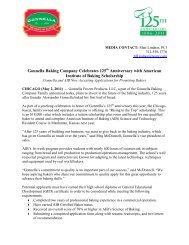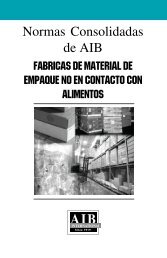Wheat Gluten in Food and Non-Food Systems
Wheat Gluten in Food and Non-Food Systems
Wheat Gluten in Food and Non-Food Systems
You also want an ePaper? Increase the reach of your titles
YUMPU automatically turns print PDFs into web optimized ePapers that Google loves.
WHEAT GLUTEN<br />
Research<br />
Department<br />
r TECHNICAL BULLETIN<br />
Editor: Gur Ranhotra<br />
I Volume XVI, Issue 6 I June, 1994<br />
WHEAT GLUTEN IN FOOD AND NON-FOOD<br />
SYSTEMS<br />
Clodualdo C. Man<strong>in</strong>gat, Ph.D., Sukh Bassi, Ph.D.<br />
Midwest Gra<strong>in</strong> Products, Inc.<br />
Atchison, KS 66002<br />
<strong>and</strong><br />
J.M. Hesser<br />
International <strong>Wheat</strong> <strong>Gluten</strong> Association<br />
Prairie Village, KS 66207<br />
INTRODUCTION formance <strong>in</strong> a variety of products.<br />
<strong>Wheat</strong> gluten (WG) is the natural water-<strong>in</strong>soluble pro- The uses of WG are wide-rang<strong>in</strong>g <strong>and</strong>, dur<strong>in</strong>g the last<br />
te<strong>in</strong> portion of wheat endosperm which, dur<strong>in</strong>g wet decade, its utilization has <strong>in</strong>tensified. This bullet<strong>in</strong><br />
process<strong>in</strong>g of wheat flour, is separated <strong>in</strong> the form of a reviews the current, <strong>and</strong> possible future, uses of WG <strong>in</strong><br />
prote<strong>in</strong>-lipid-starch complex. Commercial WG has a food <strong>and</strong> non-food areas.<br />
mean composition of 72.5% prote<strong>in</strong> (77.5% on dry<br />
basis), 5.7% total fat, 6.4% moisture <strong>and</strong> 0.7% ash;<br />
GLUTEN USAGE WORLDWIDE<br />
carbohydrates, ma<strong>in</strong>ly starches, are the other major Although the uses of WG can vary from country to<br />
component. The major prote<strong>in</strong> fractions of WG consist country, bak<strong>in</strong>g represents the predom<strong>in</strong>ant usage of<br />
of gliad<strong>in</strong> <strong>and</strong> gluten<strong>in</strong> which differ <strong>in</strong> their solubility WG, account<strong>in</strong>g for 63% of total usage worldwide (Figproperties<br />
<strong>and</strong> molecular weight. <strong>Wheat</strong> gliad<strong>in</strong>s consist ure 1). In the European Economic Community, flour<br />
of about 50 different s<strong>in</strong>gle-cha<strong>in</strong>ed prote<strong>in</strong>s with mole- fortification ranks close second to bak<strong>in</strong>g usage with pet<br />
cular weights of 30,000-100,000 daltons (1). When iso- food application rank<strong>in</strong>g third. The second lead<strong>in</strong>g use<br />
lated, gliad<strong>in</strong>s are very sticky, which apparently is re- of WG worldwide <strong>and</strong> <strong>in</strong> North America <strong>and</strong> Australia is<br />
sponsible for the cohesion property of WG. By contrast, <strong>in</strong> pet foods. Bak<strong>in</strong>g, imitation meats/fish, <strong>and</strong> procgluten<strong>in</strong><br />
prote<strong>in</strong>s are multi-cha<strong>in</strong>ed, polymerized by di- essed foods are the major uses of WG <strong>in</strong> Japan. In<br />
sulfide bonds, <strong>and</strong> larger <strong>in</strong> size with molecular weight Japan, WG is also used for the preparation of bread<br />
of about 3,000,OOO daltons. Upon isolation, gluten<strong>in</strong>s known as “Fu” bread, for the production of monosodiexhibit<br />
resiliency but neither cohesion nor extensibility um glutamate as a season<strong>in</strong>g agent, <strong>and</strong> for the prepar<strong>and</strong>,<br />
therefore, appear to give WG its elastic properties. ation of gluten hydrolyzate for use as an extender for<br />
<strong>Wheat</strong> gluten is unique among cereal <strong>and</strong> other plant<br />
prote<strong>in</strong>s because of its capacity to form a cohesive <strong>and</strong><br />
viscoelastic mass suitable for breadmak<strong>in</strong>g. The viscoelasticity<br />
appears to be because the gluten prote<strong>in</strong>s are<br />
water compatible <strong>and</strong>, thus, will swell <strong>and</strong> <strong>in</strong>teract (1).<br />
As water is taken up by WG, it goes through a glass<br />
transition where it changes from a hard glassy material<br />
to one that is rubbery <strong>and</strong> elastic. WG is also unique <strong>in</strong><br />
its ability to impart wheat flour doughs the property to<br />
reta<strong>in</strong> leaven<strong>in</strong>g gases. Other unique properties of WG,<br />
as summarized by Bushuk <strong>and</strong> McRitchie (2), are: appropriate<br />
balance <strong>in</strong> the content of gliad<strong>in</strong> <strong>and</strong> gluten<strong>in</strong>,<br />
unusually high content of the am<strong>in</strong>o acid glutam<strong>in</strong>e,<br />
<strong>and</strong> extreme polydispersity of its molecular weight.<br />
These unique properties def<strong>in</strong>e gluten’s superior per-<br />
soy sauce called “Sho-yu” (3). WG also plays an important<br />
role <strong>in</strong> the vegetarian food for the 309 million Buddhists<br />
worldwide <strong>and</strong> the 100 million Ch<strong>in</strong>ese Buddhists<br />
<strong>in</strong> which Ch<strong>in</strong>ese-style meat analogs have been made<br />
from WG by h<strong>and</strong> or simple extrusion (4).<br />
COMMERCIAL PRODUCTION<br />
OF WHEAT GLUTEN<br />
There are several processes for <strong>in</strong>dustrial production<br />
of WG, <strong>and</strong> they are named after the company or the<br />
person who developed or patented the process (5).<br />
These processes <strong>in</strong>clude: Mart<strong>in</strong>, Batter, Hydrocyclone,<br />
Pillsbury Hydromill<strong>in</strong>g, Raisio/Alfa-Laval, Modified<br />
“Fesca”, Alkali, <strong>and</strong> Far-Mar-Co. Differences exist<br />
among these processes <strong>in</strong> terms of type of raw material
Fortification<br />
Animal Feeds<br />
Bak<strong>in</strong>g<br />
Processed<br />
<strong>Food</strong>s<br />
Imitation<br />
MeaWFish<br />
25%<br />
20%<br />
EUROPEAN ECONOMIC<br />
COMMUNITY<br />
Pet <strong>Food</strong>s 8%<br />
Flour<br />
Fortification<br />
14 % Meats<br />
JAPAN<br />
Cereals 2%<br />
Bak<strong>in</strong>g<br />
63%<br />
WORLDWIDE Pet <strong>Food</strong>s 5.%<br />
Pet Fowls<br />
Others<br />
5.w<br />
FlOW<br />
Fortification<br />
11%<br />
Seafood<br />
Analogs<br />
uaculture<br />
Feeds<br />
Cereals 21%<br />
1%<br />
1.2%<br />
Bak<strong>in</strong>g<br />
67.5%<br />
NORTH AMERICA<br />
AUSTRALIA<br />
Figure 1. <strong>Food</strong> <strong>and</strong> non-food<br />
uses of wheat gluten worldwide.<br />
(whole wheat vs. flour, hard wheat vs. soft wheat, etc.), factors <strong>in</strong>volved <strong>in</strong> the production of vital WG are the<br />
dispersion procedure (water vs. chemical), consistency yield of WG, water balance, pH of flour slurry, the cost<br />
of wheat flour/water mixture (dough vs. batter), <strong>and</strong> of a system from a capital st<strong>and</strong>po<strong>in</strong>t, <strong>and</strong> the operat<strong>in</strong>g<br />
equipment for starch <strong>and</strong> gluten separation (centrifuge<br />
vs. shaker screen vs. hydrocyclone vs. agitator/ribbon<br />
blender).<br />
costs of the system.<br />
Mart<strong>in</strong> Process<br />
The Mart<strong>in</strong>, Batter, <strong>and</strong> Hydrocyclone processes are Historically, the Mart<strong>in</strong> process, developed <strong>in</strong> Paris <strong>in</strong><br />
regarded as the most popular manufactur<strong>in</strong>g methods 1835, was among the earliest <strong>and</strong> most successful proc-<br />
(discussed later) for WG production. The choice of a ess for the recovery of vital WG. A flow diagram of the<br />
process to produce vital WG is dependent on a number generalized Mart<strong>in</strong> process is shown <strong>in</strong> Figure 2, but varof<br />
different factors. In order to produce WG, it is neces- iations of this process are wideiy practiced. The Mart<strong>in</strong><br />
sary to have three th<strong>in</strong>gs: (a) a good source of raw ma- process utilized wheat flour as the start<strong>in</strong>g raw material<br />
terial flour, (b) a way to process wheat starch that is a co- <strong>and</strong> water was added <strong>in</strong> a mixer to form a dough. The<br />
product <strong>in</strong> a ratio of up to 6 (starch) to 1 (gluten), <strong>and</strong> dough was allowed to develop so that it was thoroughly<br />
(c) a method of h<strong>and</strong>l<strong>in</strong>g the effluent water from the hydrated. It then would undergo an extraction step<br />
gluten <strong>and</strong> starch manufactur<strong>in</strong>g process. In cases where more water was added to beg<strong>in</strong> the separation<br />
where sub-quality flour is used, the use of the enzymes process between the gluten <strong>and</strong> the starch. The dough<br />
pentosanases <strong>and</strong> cellulases is recommended to im- wash<strong>in</strong>g step is designed to release the starch without<br />
prove gluten yield <strong>and</strong> starch recovery. Other important dispers<strong>in</strong>g or break<strong>in</strong>g up the gluten <strong>in</strong>to small pieces.<br />
Page 2
COMPOSITION<br />
TABLE I<br />
OF DRIED WHEAT GLUTEN<br />
Component<br />
<strong>Wheat</strong> <strong>Gluten</strong><br />
Flash<br />
Dried<br />
Spray<br />
Dried<br />
Major Components, %<br />
Moisture<br />
Prote<strong>in</strong> (N x 5.7) 69.0?$.28 71.9:+&o)”<br />
Fat 1.2<br />
Fiber $‘Z 0.6<br />
Ash l:o 1.0<br />
Carbohydrates 19.4 19.9<br />
Energy, Calories/100 g 370 378<br />
Figure 2. Flow diagram of a typical Mart<strong>in</strong> process for<br />
manufacture of wheat gluten <strong>and</strong> starch (From reference<br />
5).<br />
Sufficient water is used to wash the starch from the<br />
dough while it is kneaded or rolled; devices such as ribbon<br />
blenders, rotat<strong>in</strong>g drums, tw<strong>in</strong> screw troughs, <strong>and</strong><br />
agitator vessels have been designed for this purpose.<br />
The wet gluten would then be mechanically separated<br />
from the starch <strong>in</strong> rotat<strong>in</strong>g or vibratory screens to<br />
achieve a gluten with a prote<strong>in</strong> content of 75% (dry basis).<br />
The major drawback to this system was the excessive<br />
use of water, as much as 10 to 1, which complicates<br />
starch recovery <strong>and</strong> presents a significant effluent problem<br />
which has to be addressed. Modifications of the<br />
process have been utilized <strong>in</strong> the <strong>in</strong>dustry for years.<br />
Batter Process<br />
The batter process was <strong>in</strong>vented <strong>in</strong> 1944. In this process,<br />
the batter is prepared by mix<strong>in</strong>g flour <strong>and</strong> water to<br />
yield suspended curds of gluten from which the starch<br />
has been washed out. The curds are recovered on a gyrat<strong>in</strong>g<br />
screen <strong>and</strong> the starch milk passes through. The<br />
starch is ref<strong>in</strong>ed through a series of screens, sieves <strong>and</strong><br />
centrifuges, <strong>and</strong> dried as <strong>in</strong> the Mart<strong>in</strong> process.<br />
Hydrocyclone Process<br />
Recently, KSH Company of Holl<strong>and</strong> has described a,<br />
hydrocyclone process for produc<strong>in</strong>g starch <strong>and</strong> gluten<br />
from wheat flour. A batter formed with recycled wash<br />
water <strong>and</strong> flour is <strong>in</strong>troduced directly <strong>in</strong>to a series of hydrocyclones.<br />
The “A” starch is washed out directly with<br />
counter-current fresh water. Because of the <strong>in</strong>tense fluid<br />
shear <strong>in</strong> the hydrocyclones, the gluten agglomerates <strong>in</strong>to<br />
small curds rather than large lumps. The gluten curds<br />
can be washed <strong>and</strong> separated on a rotat<strong>in</strong>g washer<br />
screen. The ma<strong>in</strong> advantage of this process is its low<br />
usage of water. Older plants, based on the Mart<strong>in</strong> or the<br />
Batter process, are be<strong>in</strong>g retrofitted with hydrocyclones<br />
M<strong>in</strong>erals, mg/lOO g<br />
Calcium 142 166<br />
Phosphorus 260 280<br />
Iron 5.2 5.7<br />
Sodium 29 106<br />
Potassium 100 68<br />
aOn dry basis.<br />
to lower operat<strong>in</strong>g costs <strong>and</strong> almost elim<strong>in</strong>ate effluent<br />
waste.<br />
WHEAT GLUTEN PRODUCTS<br />
Vital <strong>Wheat</strong> <strong>Gluten</strong><br />
WG available <strong>in</strong> the market place is predom<strong>in</strong>antly<br />
vital WG which has been dried <strong>in</strong> a flash drier. Dur<strong>in</strong>g<br />
the manufactur<strong>in</strong>g process, wet gluten is extruded <strong>in</strong>to<br />
small pellets <strong>and</strong> <strong>in</strong>jected <strong>in</strong>to a r<strong>in</strong>g or flash drier. There<br />
it is to be coated by recycl<strong>in</strong>g dry gluten <strong>in</strong> the dis<strong>in</strong>tegrator<br />
mill <strong>and</strong> subsequently dried by hot air stream.<br />
This dry<strong>in</strong>g step subjects WG to a m<strong>in</strong>imum of heat denaturation<br />
<strong>and</strong> preserves the orig<strong>in</strong>al vital-viscoelastic<br />
<strong>and</strong> cohesive-properties of wet gluten useful <strong>in</strong> bak<strong>in</strong>g<br />
<strong>and</strong> pet food applications. Table I lists the composition<br />
of flash-dried (<strong>and</strong> spray-dried) WG.<br />
WG exhibits good solubility <strong>in</strong> both acidic <strong>and</strong> alkal<strong>in</strong>e<br />
pH. This property of gluten makes it suitable for dispersion<br />
<strong>in</strong> aqueous ammonia or acetic acid solution at<br />
lo-128 solids where the dispersion can be atomized <strong>in</strong>side<br />
the hot air chamber of a spray-drier. WG dispersed<br />
<strong>in</strong> O.OlN acetic acid at 12% solids <strong>and</strong> spray dried has<br />
been reported to reta<strong>in</strong> its bak<strong>in</strong>g properties. Carbon dioxide<br />
can also be used to disperse WG to a liquid consistency<br />
suitable for pump<strong>in</strong>g <strong>and</strong> spray<strong>in</strong>g <strong>in</strong>to a dry<strong>in</strong>g<br />
chamber. Popular applications of commercial ammoniadispersed<br />
spray-dried WG (Table I) are as a prote<strong>in</strong><br />
source <strong>in</strong> nurs<strong>in</strong>g pig diets <strong>and</strong> as a b<strong>in</strong>der <strong>in</strong> float<strong>in</strong>g<br />
<strong>and</strong> s<strong>in</strong>k<strong>in</strong>g aquaculture feeds. By vary<strong>in</strong>g the dry<strong>in</strong>g<br />
procedure, other forms of WG can be produced. Aside<br />
Page 3
from flash <strong>and</strong> spray dry<strong>in</strong>g, other methods {not presently<br />
commercially employed) of dry<strong>in</strong>g WG are: vacuum<br />
dry<strong>in</strong>g, drum dry<strong>in</strong>g, <strong>and</strong> freeze dry<strong>in</strong>g. Drum dry<strong>in</strong>g<br />
procedures <strong>in</strong>clude dispers<strong>in</strong>g WG <strong>in</strong> dilute acetic<br />
acid (pH, 4.3~5.1), carbon dioxide, <strong>and</strong> ethanol followed<br />
by dry<strong>in</strong>g <strong>in</strong> a heated drum at atmospheric pressure<br />
<strong>and</strong> at a temperature of 260OF.<br />
Other WG products are available <strong>in</strong> modified forms or<br />
as a complex with other compounds. Activated <strong>Gluten</strong>@<br />
is a functiona bak<strong>in</strong>g <strong>in</strong>gredient produced by codry<strong>in</strong>g<br />
a complex of partially enzymaticalIy hydrolyzed<br />
soy lecith<strong>in</strong> <strong>and</strong> wet gluten (Kyowa Hakko Kogyo brochure).<br />
This product has dough s~engthen<strong>in</strong>g, crumb<br />
soften<strong>in</strong>g, <strong>and</strong> anti-stal<strong>in</strong>g effects <strong>in</strong> bakery products.<br />
Enhancedn <strong>Gluten</strong> is a mixture of vital WG, a type of<br />
diacetyl tartaric acid ester surfactant, <strong>and</strong> a protected<br />
form of ascorbic acid (Atochem Company brochure).<br />
When added at at level of 1% for every 2.5% fiber, EnhancedR<br />
<strong>Gluten</strong> strengthens the structure of bread<br />
ai~ow<strong>in</strong>g it to carry higher levels of fiber without deleterious<br />
effect to gra<strong>in</strong> or loaf volume. A physically modified<br />
WG (Texturized <strong>Wheat</strong> Prote<strong>in</strong>) produced by extrusion<br />
cook<strong>in</strong>g is currently ga<strong>in</strong><strong>in</strong>g acceptance <strong>in</strong> pet food<br />
<strong>and</strong> vegetarian diets,<br />
In 1972, a process was patented for produc<strong>in</strong>g an agglomerated<br />
WG which, unlike powdered WG, can be<br />
readily wetted out <strong>and</strong> dispersed <strong>in</strong> water to form a relatively<br />
stable dispersion. Another gluten product with improved<br />
dispersibility <strong>in</strong> water has been prepared by mix<strong>in</strong>g<br />
emulsifiers at a level of 15-30% with hydrated WG<br />
<strong>and</strong> then dy<strong>in</strong>g the mix~re to form an emulsified gluten.<br />
Solubiltzed <strong>Wheat</strong> <strong>Gluten</strong><br />
Soiub~l~zation of WG prote<strong>in</strong>s can be achieved by<br />
treatment with chaotropic agents, alteration of amide<br />
groups by chemical modification, removal of amide<br />
groups (deamidation) , or by depolymerization of gluten<br />
by enzymatic methods.<br />
Chemical Solubilization of <strong>Gluten</strong>: A large<br />
number of solvents are known to solubilize or disperse<br />
gluten. These <strong>in</strong>clude: 1M urea, 0.005M lactic acid,<br />
O.lM acetic acid + 3M urea-t O.OlM cetyl trimethylammonium<br />
bromide, 70% aqueous 2chloroethanol, 70%<br />
ethanol, 0.025M borate buffer, 0.025M borate buffer<br />
c 0.5% sodium dodecyl sulfate, 0.1% sodium stearate,<br />
50% propanol + 25 milIimo~ar dith~oerythrito1,<br />
0.05M acetic acid <strong>and</strong> 0.2M sodium hydroxide.<br />
Deamidation of <strong>Gluten</strong>: N<strong>in</strong>ety percent of giutamic<br />
acid (40% of the total am<strong>in</strong>o acids <strong>in</strong> WG) <strong>in</strong> WG is<br />
present as glutam<strong>in</strong>e which can be deamidated by hydrolysis<br />
to the correspond<strong>in</strong>g carboxytic acid; ionic carboxyfic<br />
groups <strong>in</strong>crease prote<strong>in</strong> so~ubili~. Deamidated<br />
WG possesses good dispersibility which makes it suitable<br />
for fortify<strong>in</strong>g foods or for foam stabilization <strong>and</strong> fat<br />
dispersion <strong>in</strong> fruit-flavored beverages. Other uses <strong>in</strong>clude<br />
meat pastes, sausages, coffee whiteners, <strong>and</strong> milk<br />
pudd<strong>in</strong>gs. Deamidation of WG can be accomplished <strong>in</strong><br />
acid, alkali, or enzyme systems, In acid or alkali systems,<br />
the prote<strong>in</strong>s which have been solubilized require<br />
neutralization before f<strong>in</strong>al isolation. This step results <strong>in</strong><br />
the formation of salts which may be removed by dialysis<br />
or ultrace~~ifuga~on or by precipitation of prote<strong>in</strong> at<br />
isoelectric po<strong>in</strong>t followed by centrifugation. Alternative-<br />
Iy, the formation of salts can be avoided by us<strong>in</strong>g acidic<br />
or basic prote<strong>in</strong>s <strong>in</strong> the neu~alization step. Deamidation,<br />
even a mild one, may produce an unpleasant<br />
soapy flavor. Us<strong>in</strong>g defatted WG may overcome this<br />
problem, but other problems arise.<br />
As mentioned earlier, deamidation of WG leads to an<br />
<strong>in</strong>crease <strong>in</strong> free carboxyl groups <strong>and</strong> net negative<br />
charge. Deamidation causes a gradual decrease <strong>in</strong> the<br />
size of gliad<strong>in</strong>-like prote<strong>in</strong>s <strong>and</strong> correspond<strong>in</strong>g <strong>in</strong>crease<br />
<strong>in</strong> low molecular weight fractions. Deamidation also<br />
causes conformational changes <strong>in</strong> gluten prote<strong>in</strong>s <strong>and</strong><br />
exposure of buried hydrophobic groups result<strong>in</strong>g <strong>in</strong> a<br />
dramatic <strong>in</strong>crease <strong>in</strong> surface hydrophobicity. No benefits<br />
<strong>in</strong> bak<strong>in</strong>g were observed when deamidated WG was<br />
added at l-4% level.<br />
Enzymatic Sol~bil~zat~on of <strong>Gluten</strong>: Molecular<br />
properties of prote<strong>in</strong>s contribute to their functionality as<br />
food <strong>in</strong>~edients, Some prote<strong>in</strong>s, however, are sometimes<br />
denatured dur<strong>in</strong>g extraction or process<strong>in</strong>g <strong>and</strong>,<br />
therefore, have limited functional properties. The most<br />
impo~ant functional property of a prote<strong>in</strong> is soiubili~<br />
s<strong>in</strong>ce a prote<strong>in</strong> generally has to be <strong>in</strong> solution to exert its<br />
other desirable effects. Solubilities of prote<strong>in</strong> can be <strong>in</strong>creased<br />
by proteolysis us<strong>in</strong>g enzymes such as fic<strong>in</strong>,<br />
bromela<strong>in</strong>, papa<strong>in</strong>, tryps<strong>in</strong> <strong>and</strong> pronase.<br />
Enzymatic modification <strong>in</strong>volves hydrolysis of peptide<br />
bonds. On a commercial scale, these hydroIytic modifications<br />
<strong>in</strong>clude chill proof<strong>in</strong>g of beer, cheese formation<br />
from milk, meat tenderization, soiubil~ation of prote<strong>in</strong><br />
concentrates, production of prote<strong>in</strong> hydrolyzates, <strong>and</strong><br />
limited hydrolysis of prote<strong>in</strong> <strong>in</strong> bread doughs among<br />
others. Soluble prote<strong>in</strong>s also have a muititude of uses <strong>in</strong><br />
foods such as prote<strong>in</strong> fortified beverages, artificial coffee<br />
whiteners, <strong>and</strong> egg white <strong>and</strong> dairy product replacers.<br />
Enzymatic prote<strong>in</strong> hydrolysis, us<strong>in</strong>g a suitable substrate<br />
like WG, also produces derivatives which exhibit aerat<strong>in</strong>g<br />
<strong>and</strong> whipp<strong>in</strong>g properties, Hyfoama 66, an enzymemodified<br />
whipp<strong>in</strong>g wheat prote<strong>in</strong>, was reported to whip<br />
much faster <strong>and</strong> to a greater volume than does egg<br />
album<strong>in</strong> or soy isolate.<br />
Enzyme modified WG, when bIended with flour at 1,<br />
1.5 or 2% levels, reduced mixograph mix<strong>in</strong>g time,<br />
far<strong>in</strong>ograph development time, <strong>and</strong> extensograph peak<br />
time. The reduction <strong>in</strong> mix<strong>in</strong>g time was ascribed to en-<br />
~matically modified WG <strong>in</strong>terfer<strong>in</strong>g with the normal hydrophobic<br />
<strong>in</strong>tera~~on occurr<strong>in</strong>g between the large gluten<br />
poiypeptides compris<strong>in</strong>g the dough structure. Test<br />
bak<strong>in</strong>g trials produced evidence that l-1.5% level of<br />
en~me-modified WG reduced optimal dough mix<strong>in</strong>g<br />
time <strong>and</strong> improved slightly loaf volume <strong>and</strong> crumb<br />
structure. Hyfoama 66, a solubilized wheat prote<strong>in</strong> with<br />
whipp<strong>in</strong>g properties, has appii~a~ons <strong>in</strong> pudd<strong>in</strong>gs, low<br />
fat <strong>in</strong>stant desserts, water ices, sherbets, frozen confections,<br />
frozen desserts <strong>and</strong> ic<strong>in</strong>gs.<br />
Hydrolyzed prote<strong>in</strong>s have been used as flavor<strong>in</strong>gs <strong>in</strong><br />
Page 4
0 UNNODIRED WNAY-WED OLvrw<br />
Ayw?ND4m<br />
b<br />
0<br />
1 2 3 4 5 6 7 3 9 10 11<br />
Figure 3. Solubility profile of So/u Pro 400 <strong>and</strong> unmodified<br />
spray dried wheat gluten at different pH levels.<br />
soup mixes, dietary supplements <strong>and</strong> whipp<strong>in</strong>g agents.<br />
This use, however, has been known to develop a bitter<br />
taste, attributed to peptides with hydrophobic character<br />
<strong>and</strong> with a molecular weight of 1000-5000. Exopeptidases<br />
which split off hydrophobic am<strong>in</strong>o acids are reported<br />
to overcome this bitterness, or move the bitter<br />
po<strong>in</strong>t to a higher degree of hydrolysis. For example, up<br />
to 30% degree of hydrolysis of WG can be achieved before<br />
any bitterness can be detected. A new solubilized<br />
wheat prote<strong>in</strong>, Solu Pro 400 (Midwest Gra<strong>in</strong> Products<br />
brochure), has been <strong>in</strong>troduced for use as a flavor enhancer<br />
<strong>and</strong> as a prote<strong>in</strong> source to replace skimmed milk<br />
<strong>in</strong> calf milk replacer formula. Solu Pro 400 exhibits excellent<br />
solubility (60~80%) <strong>in</strong> water. The effect of pH on<br />
solubility of Solu Pro 400 <strong>in</strong>clud<strong>in</strong>g its nitrogen solubility<br />
as compared to unmodified spray-dried WG is shown <strong>in</strong><br />
Figure 3. Whereas spray-dried WG is least soluble at pH<br />
6-8, Solu Pro exhibited excellent solubility at acidic,<br />
neutral <strong>and</strong> alkal<strong>in</strong>e pHs.<br />
Hydrolyzed wheat prote<strong>in</strong>s have recently ga<strong>in</strong>ed<br />
popularity <strong>in</strong> cosmetics as a component of shampoos,<br />
conditioners, creams, lotions, syndets, soap bars, lowirritat<strong>in</strong>g<br />
toothpastes <strong>and</strong> shav<strong>in</strong>g products. The benefits<br />
of hydrolyzed wheat prote<strong>in</strong> are: natural (non-animal),<br />
light color, mild odor, low ash, low molecular weight,<br />
non-irritant to eyes <strong>and</strong> sk<strong>in</strong>, non-toxic, non-sensitiz<strong>in</strong>g,<br />
good solubility, good clarity <strong>and</strong> good shelf-life stability.<br />
Aqua-Pro II is a commercially available wheat prote<strong>in</strong><br />
hydrolyzate used <strong>in</strong> cosmetics. Hydrolyzed wheat prote<strong>in</strong>s<br />
can also be used to give moistness to sponge cake,<br />
bread <strong>and</strong> Japanese confectionery.<br />
A powerful flavor enhancer derived from WG by hydrolysis<br />
(Amiflex AL-G from Takeda USA) is recommended<br />
for complete replacement of monosodium<br />
glutamate.<br />
PH<br />
d<br />
9<br />
<strong>Wheat</strong> Prote<strong>in</strong> Isolate<br />
Soy prote<strong>in</strong> isolate, <strong>in</strong>troduced <strong>in</strong> the 193Os, was<br />
considered to be the last major prote<strong>in</strong> isolate <strong>in</strong>troduced<br />
<strong>in</strong> the U.S. market. In 1984, three wheat prote<strong>in</strong><br />
isolates, produced by spray dry<strong>in</strong>g, were also <strong>in</strong>troduced<br />
<strong>in</strong> the U.S. market. <strong>Wheat</strong>pro 1000 wheat prote<strong>in</strong><br />
isolate is the <strong>in</strong>soluble isoelectric form <strong>and</strong> is comparable<br />
to acid case<strong>in</strong> <strong>and</strong> isoelectric soy prote<strong>in</strong>.<br />
<strong>Wheat</strong>pro 1100 is the soluble sodium form <strong>and</strong> <strong>Wheat</strong>pro<br />
1200 is the calcium form. These products are low <strong>in</strong><br />
lys<strong>in</strong>e, threon<strong>in</strong>e <strong>and</strong> val<strong>in</strong>e but rich <strong>in</strong> phenylalan<strong>in</strong>e<br />
<strong>and</strong> cyst<strong>in</strong>e. <strong>Wheat</strong>pro prote<strong>in</strong>s are not plagued with<br />
anti-nutritional (e.g., phytic acid <strong>and</strong> tryps<strong>in</strong> <strong>in</strong>hibitor)<br />
<strong>and</strong> flatulence problems. <strong>Wheat</strong>pro prote<strong>in</strong>s are hygroscopic<br />
<strong>and</strong> their bl<strong>and</strong> clean cereal flavor is unobtrusive,<br />
which makes them appeal<strong>in</strong>g <strong>in</strong> flavor applications. In<br />
1988, Melopro 7500 <strong>and</strong> Melopro 7600 were <strong>in</strong>troduced<br />
<strong>in</strong> the wheat prote<strong>in</strong> isolate market. They conta<strong>in</strong><br />
about 95% prote<strong>in</strong> (dry basis) <strong>and</strong> are recommended as<br />
a partial or total replacer for sodium case<strong>in</strong>ate <strong>and</strong> calcium<br />
case<strong>in</strong>ate, respectively. Applications <strong>in</strong>clude bakery<br />
products, bread<strong>in</strong>gs <strong>and</strong> batters, dietary beverages<br />
<strong>and</strong> meat emulsions.<br />
WPI 100 <strong>and</strong> LSI are two wheat prote<strong>in</strong> isolates presently<br />
be<strong>in</strong>g marketed for use <strong>in</strong> imitation cheese, bakery<br />
products, whipped topp<strong>in</strong>gs, coffee whiteners, meat<br />
emulsions, powdered shorten<strong>in</strong>gs, <strong>and</strong> nutritional beverages.<br />
They conta<strong>in</strong> 94.0-96.046 prote<strong>in</strong> (dry basis),<br />
6.4-7.0% moisture, <strong>and</strong> 1.1-1.68 ash. <strong>Wheat</strong>pro <strong>and</strong><br />
Melopro prote<strong>in</strong> isolates are presently not commercially<br />
available.<br />
Chemically Modified <strong>Wheat</strong> <strong>Gluten</strong><br />
The functional properties of prote<strong>in</strong>s <strong>in</strong> foods determ<strong>in</strong>e<br />
its overall behavior or performance dur<strong>in</strong>g manufactur<strong>in</strong>g,<br />
process<strong>in</strong>g, storage <strong>and</strong> consumption. These<br />
properties are affected by the composition (am<strong>in</strong>o acid<br />
profile) <strong>and</strong> conformation (structural) of prote<strong>in</strong> <strong>and</strong> its<br />
<strong>in</strong>teraction with other food constituents. The functional<br />
properties of prote<strong>in</strong> that are of paramount importance<br />
<strong>in</strong> food systems <strong>in</strong>clude solubility, emulsification, water<br />
<strong>and</strong> oil absorption, gelation or coagulation, foam<strong>in</strong>g,<br />
viscosity, texture, adhesion, cohesion <strong>and</strong> film formation.<br />
<strong>Food</strong> applications require prote<strong>in</strong>s with (a) emulsify<strong>in</strong>g<br />
properties which are important <strong>in</strong> sausage-type<br />
meats <strong>and</strong> coffee whiteners, (b) hydration <strong>and</strong> water<br />
b<strong>in</strong>d<strong>in</strong>g which are critical <strong>in</strong> doughs <strong>and</strong> meat products,<br />
(c) viscosity which is important for beverages like liquid<br />
<strong>in</strong>stant breakfasts, (d) gelation which is required <strong>in</strong><br />
marshmallows <strong>and</strong> cold meat products, (e) foam<strong>in</strong>g or<br />
whipp<strong>in</strong>g property which is vital <strong>in</strong> whipped topp<strong>in</strong>gs,<br />
<strong>and</strong> (f) cohesion which is important <strong>in</strong> textured products.<br />
Despite the unique properties of WG, it lacks some<br />
important functional characteristics that other cereal,<br />
legume, microbial <strong>and</strong> animal prote<strong>in</strong>s possess. Thus,<br />
the open<strong>in</strong>g of new markets <strong>and</strong> the potential diversification<br />
of its uses requires the modification of its physicochemical<br />
properties. The functional properties of a pro-<br />
Page 5
te<strong>in</strong> can be modified by physical, biological or chemical<br />
means.<br />
Physical modification <strong>in</strong>volves changes <strong>in</strong> particle size<br />
through application of temperature, removal of volatiles<br />
<strong>and</strong> moisture, <strong>and</strong> alteration <strong>in</strong> form through application<br />
of stress. Biological modification essentially refers to<br />
fermentation processes, while chemical modification refers<br />
to alteration ofjthe physic~hemi~l’, nature of the<br />
prote<strong>in</strong> through pH change, derivatization, en~matic<br />
digestion, ionic manipulation, <strong>and</strong> complex formation.<br />
Chemical modifications of prote<strong>in</strong>s can be classified<br />
<strong>in</strong>to two divisions: (a) those that are performed <strong>in</strong>tentionally<br />
for specific purposes, <strong>and</strong> (b) those that can be<br />
described as deteriorative or <strong>in</strong>cidental to the process<strong>in</strong>g,<br />
storage, or ag<strong>in</strong>g of prote<strong>in</strong>-conta<strong>in</strong><strong>in</strong>g materials.<br />
Intentional modification <strong>in</strong>volves acylation or related reactions,<br />
alkylation, reduction <strong>and</strong> oxidation <strong>and</strong> aromatic<br />
r<strong>in</strong>g substitution. Maillard reaction <strong>and</strong> lys<strong>in</strong>oalan<strong>in</strong>e<br />
forma~on are examples of <strong>in</strong>cidental or non<strong>in</strong>tentional<br />
type of modification.<br />
WG treated with chiorosulfonic acid <strong>in</strong> pyrid<strong>in</strong>e, cold<br />
sulfuric acid or with-phosphoric acid <strong>and</strong> urea yields<br />
products which absorb 100-300 times their weight <strong>in</strong><br />
water <strong>and</strong> have therapeutic (e.g., post-operative dra<strong>in</strong>age),<br />
cosmetic (e.g., jellies <strong>and</strong> o<strong>in</strong>tments) <strong>and</strong> food<br />
(e.g., emulsify<strong>in</strong>g agent <strong>in</strong> ice cream) uses.<br />
Acylation of WG with succ<strong>in</strong>ic or citraconic anhydrides<br />
<strong>in</strong>creases prote<strong>in</strong> solubility at phi 7 <strong>and</strong> 9 but decreases<br />
at pH 3. Emulsify<strong>in</strong>g capacity, water sorption,<br />
<strong>and</strong> water hold<strong>in</strong>g capacity of wheat prote<strong>in</strong> are improved<br />
by acylation. Succ<strong>in</strong>ylation decreases dough<br />
extensibility but does not significantly affect specific loaf<br />
volume. Succ<strong>in</strong>ylated <strong>and</strong> maleylated WG exhibit better<br />
water solubility <strong>and</strong> slightly better bak<strong>in</strong>g performance<br />
compared to acetylated, propionylated, butyrylated,<br />
palmitylated, <strong>and</strong> phthalylated derivatives of WG.<br />
USE OF GLUTEN IN BAKERY PRODUCTS<br />
As mentioned earlier (Figure l), the predom<strong>in</strong>ant use<br />
of WG is <strong>in</strong> bakery products. In many wholesale <strong>and</strong><br />
large retail bakeries, vital WG is the st<strong>and</strong>ard <strong>in</strong>gredient<br />
used <strong>in</strong> fortify<strong>in</strong>g doughs where many variety bread <strong>in</strong>gredients<br />
such as bran, cracked wheat, other gra<strong>in</strong>s, or<br />
a dietary fiber stress the ability of wheat dough to reta<strong>in</strong><br />
gas, <strong>and</strong> to give good oven spr<strong>in</strong>g <strong>and</strong> f<strong>in</strong>al loaf volume.<br />
Table II lists bakery products where WG is rout<strong>in</strong>ely used.<br />
In general, the functions of WC <strong>in</strong> food (or non-food)<br />
products are as s~en~hener or enhancer, film former,<br />
b<strong>in</strong>der, texturizer, fat emulsify<strong>in</strong>g agent, process<strong>in</strong>g aid,<br />
stabilizer <strong>and</strong> thickener, water absorption <strong>and</strong> retention<br />
agent, thermosett<strong>in</strong>g agent, <strong>and</strong> as an agent for flavor<br />
<strong>and</strong> color. WG properties useful <strong>in</strong> bakery products are:<br />
viscoelastic properties for dough strength, film-form<strong>in</strong>g<br />
ability for gas <strong>and</strong> moisture retention, thermose~<strong>in</strong>g<br />
properties for structural rigidity, water absorption <strong>and</strong><br />
retention capacity for product softness, <strong>and</strong> natural<br />
flavor.<br />
Dur<strong>in</strong>g the process of bread dough formation, WG <strong>in</strong>teracts<br />
with water <strong>and</strong> undergoes glass transition to yield<br />
Product<br />
TABLE II<br />
USE OF VITAL WHEAT GLWTEN<br />
IN BAKERY PRODUCTS<br />
Use Level<br />
(X , Flour Basis)<br />
Pizza Crust l-2<br />
Vienna Bread, Hamburger<br />
Buns, Hard Rolls? Bran<br />
Bread, Brown Soft Roils 2<br />
<strong>Wheat</strong> Bread with Bran 3<br />
Salad Rolls 4<br />
Multi-Gra<strong>in</strong> Bread 4-5<br />
High Prote<strong>in</strong> Bread, Bagels 5<br />
Whole Meal Fiber-Increased<br />
Bread 6<br />
Whole <strong>Wheat</strong> Bread from<br />
Flaked <strong>Wheat</strong> 10<br />
Bread with Low Slice<br />
Weight 30<br />
Source: International <strong>Wheat</strong> <strong>Gluten</strong> Ass~iation.<br />
a rubbery <strong>and</strong> elastic mass. Dur<strong>in</strong>g oven bak<strong>in</strong>g, WG retards<br />
the movement of water through the dough which<br />
is the same type of phenomenon responsible for retention<br />
of carbon dioxide <strong>in</strong> bread dough. Yeast produces<br />
carbon dioxide which saturates the aqueous phase <strong>and</strong><br />
excess carbon dioxide diffuses <strong>in</strong>to the unsaturated gaseous<br />
phase. As a result, the viscoelastic dough will flow<br />
or exp<strong>and</strong> to equalize the pressure created by the excess<br />
gas. The highly hydrated gluten matrix that forms the<br />
cont<strong>in</strong>uous phase <strong>in</strong> bread dough has high apparent viscosity<br />
that retards diffusion of leaven<strong>in</strong>g gas through the<br />
matrix. Dur<strong>in</strong>g the conversion of dough to bread, heattriggered<br />
changes occur. Disulfide <strong>and</strong> cross-l<strong>in</strong>ked<br />
bonds are formed <strong>and</strong> the cross-l<strong>in</strong>ks appear to be responsible<br />
for the sett<strong>in</strong>g of the loaf of bread.<br />
USE OF GLUTEN IN PET FOODS<br />
Widely used <strong>in</strong> pet foods, WG is used to supply prote<strong>in</strong><br />
<strong>and</strong> specific am<strong>in</strong>o acids <strong>and</strong> as a key <strong>in</strong>gredient <strong>in</strong><br />
specific formulations for .its water <strong>and</strong> fat b<strong>in</strong>d<strong>in</strong>g <strong>and</strong> its<br />
texturiz<strong>in</strong>g properties. In 1975, WG was used to develop<br />
a high prote<strong>in</strong>, low cost meat product which has the<br />
appearance of chunks of red meat, especially fatmarbled<br />
meat. WG not only has the property to b<strong>in</strong>d<br />
chunks of meat together, both <strong>in</strong> the raw <strong>and</strong> cooked<br />
form, but also acts as a moisture b<strong>in</strong>d<strong>in</strong>g agent to absorb<br />
the natural juices of meat. Preparation of a semi-moist<br />
meat product conta<strong>in</strong><strong>in</strong>g heat-coagulated WG suitable<br />
for feed<strong>in</strong>g to domestic pets has also been reported; patent<br />
has also been issued for a simulated meat product<br />
conta<strong>in</strong><strong>in</strong>g 1545% WG which is heat coaguiated to<br />
form fibrous elements. WG has also been <strong>in</strong>corporated<br />
as a stiffen<strong>in</strong>g or texturiz<strong>in</strong>g agent <strong>in</strong> a semi-moist food<br />
product imitat<strong>in</strong>g the appearance of marbled meat <strong>in</strong>-<br />
Page 6
tended for domestic animals.<br />
USE OF GLUTEN IN MEAT PRODUCTS<br />
Because of its b<strong>in</strong>d<strong>in</strong>g property <strong>and</strong> meat-like characteristics,<br />
the use of WG <strong>in</strong> meat products is widespread.<br />
WG improved the utilization of beef, pork <strong>and</strong> lamb<br />
meats by a restructur<strong>in</strong>g process which converts less desirable<br />
fresh meat cuts <strong>in</strong>to more palatable steak-type<br />
products. Vital WG has proven as a satisfactory b<strong>in</strong>der<br />
for turkey meat pieces because of its ability to produce<br />
<strong>in</strong>tact loaves with good slic<strong>in</strong>g qualities. In processed<br />
meat products, it is the salt-soluble myofibrillar prote<strong>in</strong><br />
(myos<strong>in</strong>) which forms a viscoelastic gel matrix upon solubilization<br />
<strong>and</strong> heat<strong>in</strong>g. WC participates <strong>in</strong> network formation<br />
of myos<strong>in</strong> or performs other important functions.<br />
For example, <strong>in</strong> formulated meat products, WG<br />
at 12.4% is comb<strong>in</strong>ed with pork fatback (43.1%), hot<br />
water (43.1%), <strong>and</strong> salt (1.4%) to form emulsified fat<br />
batters which are <strong>in</strong>corporated <strong>in</strong>to f<strong>in</strong>ely cornm<strong>in</strong>uted<br />
sausages like frankfurters.<br />
Simulated ‘meat products have been prepared from<br />
WG (100 parts), defatted soybean meal (10 parts) <strong>and</strong><br />
TABLE III<br />
USE LEVEL OF GLUTEN<br />
IN NON-BAKERY PRODUCTS<br />
Product Use Level (5%)<br />
Seafood Analogs<br />
Imitation Cheese<br />
5X3<br />
High-Prote<strong>in</strong> Pasta 1.6<br />
Frankfurters 3.2<br />
Flour Tortillas 2.5<br />
Pet <strong>Food</strong>s 3-28.2<br />
Aquaculture Diet 5-10<br />
Sausage Analog<br />
Synthetic Cheese 1:2<br />
Extruded/Fibrous <strong>Wheat</strong><br />
<strong>Gluten</strong> Products 20-23<br />
Pharmaceutical Tablets<br />
Paper Coat<strong>in</strong>g :-:<br />
Biodegradable <strong>Gluten</strong> Plastic 60<br />
Meat-Like Sausage 16.7<br />
Meat-Like Balls <strong>and</strong><br />
Hamburger 10.6<br />
Cigarette Filter 25<br />
Chew<strong>in</strong>g Gum 50<br />
Edible Films <strong>and</strong> Coat<strong>in</strong>gs 4.9-13.2<br />
Pressure Sensitive Adhesive<br />
Tape 49.5<br />
Crab Analog 2.1<br />
Artificial Caviar l-30<br />
Glue 10<br />
Restructured Beef Steaks 3.6<br />
Mer<strong>in</strong>gue 15.1<br />
High-Prote<strong>in</strong> Snack 2.2<br />
Source: Sukh Bassi (Midwest Gra<strong>in</strong> Products, Inc.)<br />
dried egg whites (20 parts} which possessed a fibrous<br />
texture. The product can be blended with natural meats<br />
to make hamburger <strong>and</strong> sausage. In Japan, a crab meat<br />
was produced by blend<strong>in</strong>g WG with a reduc<strong>in</strong>g agent<br />
such as cyste<strong>in</strong>e <strong>and</strong> a foam<strong>in</strong>g agent such as sodium bicarbonate<br />
<strong>and</strong> then coagulated by heat with stirr<strong>in</strong>g <strong>in</strong><br />
the presence of water <strong>and</strong> red dye to fiberize the structure.<br />
Table III lists the use level of WG <strong>in</strong> various nonbakery-food<br />
<strong>and</strong> non-food-products.<br />
USE OF GLUTEN IN CALF MILK REPLACERS<br />
Calf milk replacers are artificial milk or milk imitations<br />
which were orig<strong>in</strong>ally based on at least 60% skimmed<br />
milk powder. In Western Europe <strong>and</strong> North America, it<br />
is, for various reasons, a common practice to separate<br />
the mother from young as soon as possible. Milk replacers<br />
are, therefore, designed to be fed to weaned<br />
youngs. Calves need a milk replacer that is soluble, or at<br />
least held <strong>in</strong> a stable non-viscous emulsion, <strong>and</strong> is<br />
palatable. The objective is to achieve prote<strong>in</strong> quality <strong>in</strong><br />
the replacers equivalent to that of case<strong>in</strong>. Because of<br />
the variability <strong>in</strong> price of skimmed milk <strong>and</strong> whey<br />
powders, alternative sources of prote<strong>in</strong> such as soy <strong>and</strong><br />
WG are be<strong>in</strong>g considered to provide the am<strong>in</strong>o acid requirements<br />
of calves. In particular, a solubilized wheat<br />
prote<strong>in</strong>, Solu-Pro 400, with 60-80% solubili~ <strong>in</strong> water<br />
is be<strong>in</strong>g used commercially as a prote<strong>in</strong> replacer for<br />
skimmed milk <strong>in</strong> calf milk formula.<br />
FILMS AND COAnNGS FROM GLUTEN<br />
Major <strong>in</strong>dustrial markets for prote<strong>in</strong>s <strong>in</strong> general are as<br />
fiber, films or adhesive compositions. WG does not lend<br />
itself easily to fiber formation but films can be prepared<br />
from a 20% solution of WG <strong>in</strong> a solvent mixture compris<strong>in</strong>g<br />
60% ethanol, 20% lactic acid <strong>and</strong> 20% water.<br />
In 1972, a process was patented for produc<strong>in</strong>g edible<br />
<strong>and</strong> odor-free gluten films <strong>and</strong> coat<strong>in</strong>gs which can be<br />
used to wrap, package or encase cheese, s<strong>and</strong>wiches,<br />
<strong>and</strong> hors d’oeuvres. In confectionery products, edible<br />
films can serve as oxygen <strong>and</strong> moisture barriers. Recently,<br />
there has been a revival of <strong>in</strong>terest <strong>in</strong> WG films<br />
<strong>and</strong> coat<strong>in</strong>gs to extend shelf-life of foods by offer<strong>in</strong>g a<br />
selective barrier aga<strong>in</strong>st the transmission of gases (vapors)<br />
, moisture, <strong>and</strong> solutes while also offer<strong>in</strong>g mechanical<br />
protection.<br />
OTHER NON-FOOD USES OF GLUTEN<br />
WG <strong>and</strong> its derivatives also have unique <strong>and</strong> special<br />
applications <strong>in</strong> adhesive tapes, cigarette filters <strong>and</strong> pharmaceutical<br />
tablets (Table III). Ethylene oxide-treated<br />
WG, when copofymerized with hydroxyethyl methacrylate,<br />
was shown to exhibit properties important <strong>in</strong><br />
pressure-sensitive tapes. WG has also been used as a<br />
component of chew<strong>in</strong>g gums to make it more hygienic,<br />
palatable, nutritional <strong>and</strong> readily digestible, if accidentally<br />
swallowed. As a component of cigarette filter material,<br />
WG has a high adsorption rate of tar, shows no resistance<br />
to the passage of smoke, <strong>and</strong> does not <strong>in</strong>terfere<br />
with the taste of cigarette smoke. In pharmaceutical<br />
Page 7
tablets, WG can be added as a b<strong>in</strong>der at a level of<br />
2-5%. In the paper coat<strong>in</strong>g <strong>in</strong>dustry, chemically modified<br />
WG when used as a co-b<strong>in</strong>der (i.e., anchors the<br />
pigments to each other <strong>and</strong> the raw paper) exhibits<br />
equal or superior properties than modified soy prote<strong>in</strong><br />
isolate <strong>in</strong> b<strong>in</strong>d<strong>in</strong>g power, wet-pick<strong>in</strong>g resistance, whiteness,’<br />
activation of optical brightness, pr<strong>in</strong>tability <strong>and</strong><br />
water retention capacity.<br />
Many other non-food <strong>and</strong> non-feed uses of WG are<br />
possible. They <strong>in</strong>clude detergent formulations, adhesives<br />
for plywood <strong>and</strong> ceramics, slow-release pharmaceuticals,<br />
medical b<strong>and</strong>ages <strong>and</strong> gloves, dry cell battery,<br />
textiles <strong>and</strong> leather, construction materials such as<br />
plaster <strong>and</strong> concrete, rubber, waste recovery, scale <strong>in</strong>hibitor<br />
<strong>in</strong> water, thermal record<strong>in</strong>g materials, fuel cells,<br />
weed control, <strong>and</strong> fire-retardant polyurethane foam. Indeed,<br />
WG is a multi-functional, annually renewable<br />
prote<strong>in</strong> product.<br />
SUMMARY<br />
<strong>Wheat</strong> gluten is unique among cereal <strong>and</strong> other plant<br />
prote<strong>in</strong>s because of its capacity to form a cohesive <strong>and</strong><br />
viscoelastic mass suitable for bakery <strong>and</strong> other food<br />
products as well as for non-food uses. Worldwide, bak<strong>in</strong>g<br />
represents the predom<strong>in</strong>ant, 63%, usage of wheat<br />
gluten; the second lead<strong>in</strong>g use is <strong>in</strong> pet foods. A variety<br />
of gluten products-vital wheat gluten, solubilized<br />
wheat gluten, prote<strong>in</strong> isolate, complexed gluten, <strong>and</strong><br />
hydrolyzed wheat prote<strong>in</strong>-are commercially available<br />
for food <strong>and</strong> non-food uses.<br />
1.<br />
2.<br />
3.<br />
4.<br />
5.<br />
REFERENCES<br />
HOSENEY, R.C. <strong>and</strong> ROGERS, D.E. The formation<br />
<strong>and</strong> properties of urheat flour doughs. Crit. Rev.<br />
<strong>Food</strong> Sci. <strong>and</strong> Nutr., 29: 73, 1990.<br />
BUSHUK, W, <strong>and</strong> McRlTCHlE, F. <strong>Wheat</strong> prote<strong>in</strong>s:<br />
Aspects of structure that determ<strong>in</strong>e breadmak<strong>in</strong>g<br />
quality. In: Prote<strong>in</strong> Quality <strong>and</strong> the Effects of Process<strong>in</strong>g<br />
(eds. F<strong>in</strong>ley <strong>and</strong> Phillips). Marcel Dekker,<br />
NY; 1989.<br />
ENDO, S., NOMURA, S., ISHIGAMI, S., <strong>and</strong><br />
KARIBE, S. Modified gluten product <strong>and</strong> bread improuer<br />
composition. U.S. Patent 4, 879, 133, 1989.<br />
HUANG, Y-W, <strong>and</strong> ANG, C. Y W Vegetarian foods<br />
for Ch<strong>in</strong>ese Buddhists. <strong>Food</strong> Tech., 46:105, 1992.<br />
KNIGHT, J. W, <strong>and</strong> OLSON, R.M. <strong>Wheat</strong> starch:<br />
Production, modification <strong>and</strong> uses. In: Starch Chemistry<br />
<strong>and</strong> Technology (eds. Whistler, BeMiller <strong>and</strong><br />
PaschalI). Academic Press, Inc., Nk: 1984.<br />
Page 8


